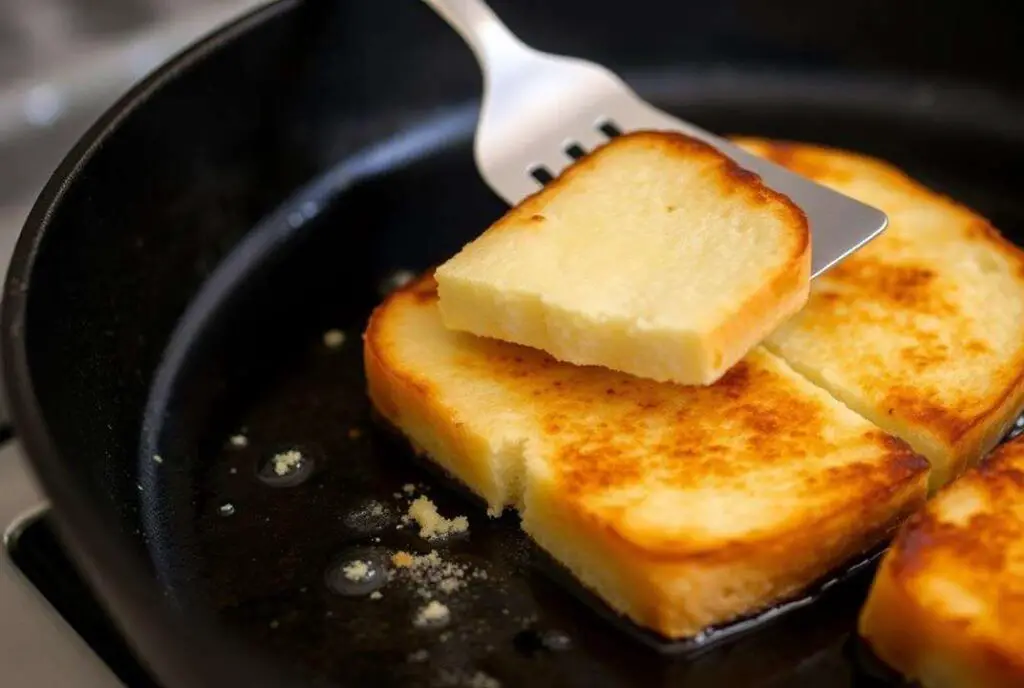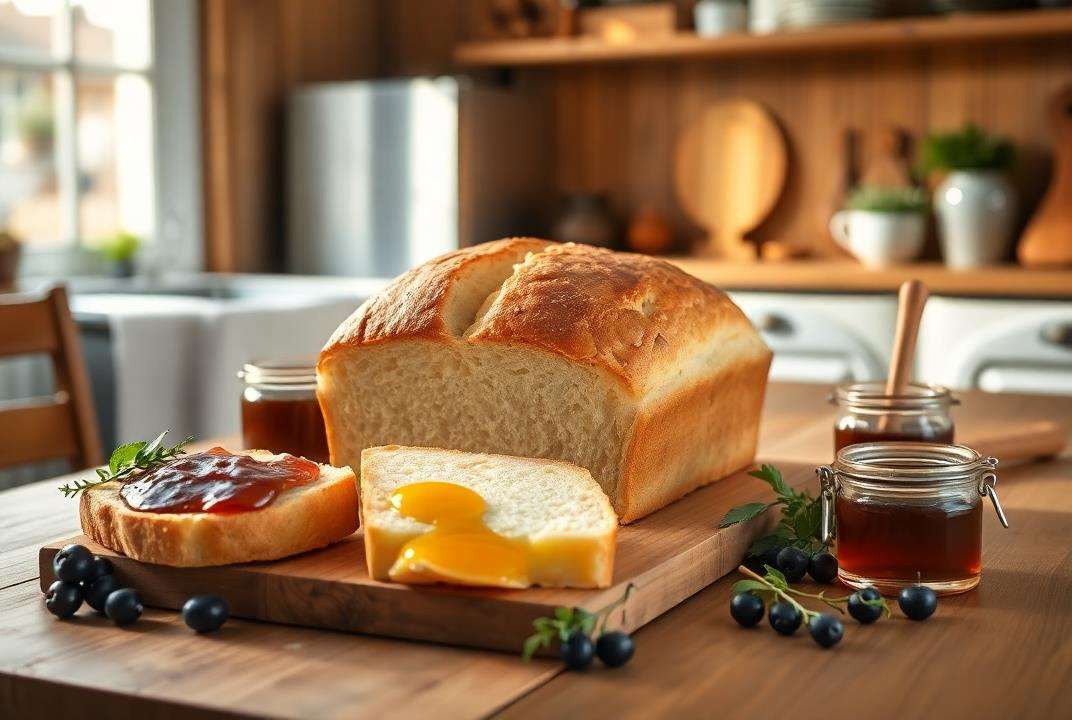Bread cheese, a unique culinary gem with roots in Scandinavia, has been captivating food lovers with its rich, creamy texture and versatility. Whether you’re a fan of traditional Nordic cuisine or just curious about this fascinating cheese that doesn’t melt, there’s something here for everyone. In this article, we’ll dive deep into what bread cheese is, its origins, cooking methods, health benefits, and even creative ways to enjoy it. From sweet pairings to savory dishes, you’ll discover why bread cheese deserves a spot in your kitchen. Let’s get started!
Table of Contents
What is Bread Cheese?
Understanding Bread Cheese: Definition and Origins
Bread cheese, known as Juustoleipä in Finland, is a semi-soft, baked cheese that boasts a squeaky texture when you bite into it. Unlike most cheeses, it holds its shape even when heated, making it a delightful choice for grilling or frying. The name “bread cheese” comes from its resemblance to a slice of toasted bread when baked, complete with a golden-brown crust and a creamy, slightly chewy interior.
This cheese originated in the Nordic regions, specifically Finland, where it’s been a traditional delicacy for centuries. Traditionally, it was made from cow’s or reindeer’s milk, although modern versions often use cow or goat milk. Its unique preparation involves baking the cheese until it forms a caramelized crust—a process that enhances its flavor and texture.
Why It’s Called Bread Cheese
The moniker “bread cheese” might be a bit confusing at first. However, it perfectly describes the cheese’s appearance. When baked, the outer crust of Juustoleipä resembles toasted bread. Plus, its dense, sponge-like texture allows it to absorb flavors and sauces, just like bread does. While it doesn’t actually contain any bread, the name has stuck, and it perfectly captures the cheese’s essence.
Cultural Significance and History of Bread Cheese
Bread cheese isn’t just food—it’s a piece of history. In Finland, Juustoleipä has long been considered a comfort food, often enjoyed with cloudberry jam or coffee. It’s more than a snack; it’s a way to connect with Nordic traditions. Over the years, it has gained global recognition, becoming a favorite among adventurous foodies and cheese enthusiasts alike. Its long shelf life and versatility also made it a staple for Nordic farmers and travelers in the past, adding to its cultural importance.
Types of Bread Cheese and Their Varieties
Traditional Bread Cheese from Finland
The origins of bread cheese lie in Finland, where it is called Juustoleipä. This traditional version is crafted from cow’s or reindeer’s milk, with a process that involves curdling, baking, and sometimes even grilling. The unique preparation method gives it its characteristic caramelized crust and squeaky texture. Finnish bread cheese is often paired with sweet jams like cloudberry to balance its mild, slightly tangy flavor. This Scandinavian delicacy has been a staple in Finnish households for centuries and remains a cherished part of their culinary culture.
Modern Interpretations Around the World
While Juustoleipä holds its traditional roots, modern adaptations of bread cheese have popped up globally. Some versions use goat milk to introduce a richer, tangier flavor profile, while others experiment with added herbs or spices for a more contemporary twist. These variations can be found in specialty cheese shops and are often incorporated into creative recipes like bread cheese burgers or even dessert dishes. Bread cheese has become popular among chefs for its ability to stay intact when cooked, making it ideal for grilling and pan-frying.
The Best Cheeses for Making Bread Cheese
If you’re looking to recreate bread cheese at home, cheeses like halloumi or paneer can serve as substitutes, although they don’t have the same caramelized crust. For authenticity, it’s best to source Juustoleipä or its equivalents from Scandinavian markets. Many online retailers now offer bread cheese, making it easier than ever to enjoy this savory delight. Interested in other cheese pairings? Check out Sophia’s Meals’ guide to cheesy casseroles for more inspiration.
How to Cook and Enjoy Bread Cheese
Different Cooking Techniques for Bread Cheese

One of the best things about bread cheese is its versatility in the kitchen. This cheese doesn’t melt when heated, making it perfect for frying, grilling, or baking. A popular method is pan-frying it in a nonstick skillet until it develops a golden crust. Alternatively, you can grill it over an open flame to bring out a smoky, caramelized flavor. Baking it in the oven also works well, especially when paired with herbs or honey.
Serving Suggestions for Bread Cheese
Bread cheese can be served in a variety of ways, from appetizers to desserts. For a simple yet delicious snack, slice the cheese into cubes and serve it with toothpicks alongside dips like honey or spicy jams. It also works beautifully as a topping for salads, adding a chewy, savory element that contrasts with crisp greens. Another classic way to enjoy bread cheese is by pairing it with roasted vegetables or cured meats for a hearty platter.
Sweet vs. Savory Pairings with Bread Cheese
The beauty of bread cheese is that it pairs equally well with sweet and savory flavors. For a sweet treat, drizzle the warm cheese with honey or top it with fruit preserves. Cloudberry jam is a traditional favorite, but lingonberry or fig jam work just as well. On the savory side, serve bread cheese with smoked meats, fresh herbs, or even as a substitute for mozzarella in pizzas. Want more ideas? Try experimenting with bread cheese as an ingredient in these savory dips and sauces.
How to Make Homemade Bread Cheese
Ingredients for Homemade Bread Cheese
Making bread cheese at home is simpler than you might think, and the ingredients are easy to find. You’ll need:
- 1 gallon of whole milk (cow or goat milk works best)
- 1/2 cup of buttermilk
- 1/4 cup of white vinegar or lemon juice
- 1 teaspoon of salt
- Optional: Fresh herbs or spices for added flavor
Step-by-Step Recipe for Homemade Bread Cheese
- Heat the Milk: Pour the milk into a large pot and heat it over medium heat until it reaches 185°F (85°C). Use a kitchen thermometer for accuracy. Stir occasionally to prevent scorching.
- Add the Acid: Once the milk is heated, add the vinegar or lemon juice a little at a time, stirring gently. You’ll see the milk start to curdle, separating into curds and whey.
- Strain the Curds: Remove the pot from the heat and let it sit for 5 minutes. Then, pour the mixture through a cheesecloth-lined colander to separate the curds from the whey. Press lightly to remove excess liquid.
- Season the Cheese: Transfer the curds to a mixing bowl and stir in the salt. If you’d like, you can also mix in fresh herbs like thyme or rosemary for an extra flavor boost.
- Shape and Bake: Press the seasoned curds into a round or square baking dish lined with parchment paper. Bake in a preheated oven at 375°F (190°C) for 20-25 minutes, or until the cheese forms a golden crust.
- Cool and Enjoy: Let the cheese cool slightly before slicing. Your homemade bread cheese is now ready to enjoy as is or paired with your favorite toppings.
Pro Tips for Homemade Bread Cheese
- Use high-quality milk for the best flavor and texture.
- Experiment with flavors by adding garlic, chili flakes, or even grated parmesan to the curds.
- Store leftover bread cheese in the refrigerator for up to a week, reheating it in a skillet before serving.
Health Benefits and Nutritional Profile
Calories and Macronutrient Breakdown
If you’re mindful of your diet but still want to indulge, bread cheese might be a great addition to your meals. Typically, a serving of bread cheese is low in carbohydrates, making it a good option for low-carb or keto diets. A single serving contains around 100-120 calories, depending on the type of milk used, with a balanced ratio of protein and fat. Its high protein content is particularly beneficial for those looking to maintain or build muscle.
Protein and Fat Content in Bread Cheese
Bread cheese is packed with protein, making it a satisfying snack or meal component. On average, a single serving provides about 7-9 grams of protein, which helps keep you full and energized. Its moderate fat content, around 6-8 grams per serving, gives it a creamy richness without being overly indulgent. This balance of macronutrients makes bread cheese both delicious and nutritionally valuable.
Is Bread Cheese a Healthy Option?
While bread cheese is a great source of protein and calcium, it’s important to enjoy it in moderation due to its sodium content. Like many cheeses, it’s slightly salty, which enhances its flavor but may not be ideal for those on a low-sodium diet. However, when paired with fresh fruits or vegetables, it can be part of a wholesome and balanced diet. Looking for other healthy snack ideas? Check out Sophia’s Meals’ guide to lupini beans for more inspiration.
FAQs about Bread Cheese
What Type of Cheese is Bread Cheese?
Bread cheese is a semi-soft, baked cheese that originates from Finland, where it’s traditionally called Juustoleipä. It’s made by baking the cheese until it forms a golden crust, giving it its signature bread-like appearance.
How Are You Supposed to Eat Bread Cheese?
There’s no one “right” way to enjoy bread cheese! It can be pan-fried, grilled, or even eaten as is. Pair it with sweet toppings like honey or jam for a dessert-style treat, or serve it alongside meats and vegetables for a savory meal.
What Is Bread Cheese Similar To?
If you’ve tried halloumi or paneer, you’ll notice some similarities to bread cheese. Like these cheeses, it holds its shape when heated, making it perfect for grilling or frying. However, its caramelized crust and creamy texture set it apart.
What Is Bread Cheese’s Real Name?
The real name for bread cheese is Juustoleipä, a Finnish word that translates to “cheese bread.” This reflects its bread-like appearance and its cultural roots in Finland.
For more cheese-related recipes and ideas, explore Sophia’s Meals’ collection of creative cheese dishes.
Creative Recipes Using Bread Cheese
Bread Cheese Pizza
If you love pizza but want to try something different, bread cheese makes an excellent base or topping. For a quick recipe, pan-fry or bake the cheese until golden and bubbly, then top it with tomato sauce, fresh basil, and your favorite toppings. You can even use small rounds of bread cheese as mini pizza crusts for bite-sized snacks. The rich, creamy texture of bread cheese perfectly complements savory toppings like pepperoni, olives, or roasted vegetables.
Bread Cheese Sandwiches
For a hearty sandwich with a unique twist, substitute bread cheese for traditional cheese slices. Layer the bread cheese with fresh vegetables, smoked meats, or even caramelized onions between slices of crusty bread. Grill the sandwich until the cheese softens and the bread turns crispy. This recipe works wonders for lunch or a comforting dinner. Adding a drizzle of honey or a swipe of Dijon mustard takes the flavor to the next level.
Bread Cheese as a Dessert Ingredient

Did you know bread cheese works just as well in desserts as it does in savory dishes? A popular option is to grill the cheese and serve it with a drizzle of honey or maple syrup, topped with fresh fruits like berries or figs. You can also chop it into cubes and add it to fruit salads or bake it into puff pastry for a cheesy, sweet surprise. For more dessert inspiration, consider Sophia’s Meals’ easy dessert recipes.
Where to Buy the Best Bread Cheese
Online Stores Specializing in Bread Cheese
Finding authentic bread cheese has never been easier, thanks to online specialty stores. Many retailers now offer Juustoleipä that can be shipped directly to your door. Websites like Scandinavian food markets and artisan cheese shops often stock traditional bread cheese as well as modern variations. Be sure to read reviews to ensure quality, and look for cheeses made from natural ingredients.
Local and International Specialty Shops
If you prefer to shop locally, check out specialty food shops in your area that carry Nordic or gourmet cheeses. Farmer’s markets and high-end grocery stores are also great places to find fresh, locally made versions of bread cheese. When shopping in person, ask the cheesemonger for recommendations or pairing suggestions to enhance your experience.
For more tips on where to source unique ingredients, visit Sophia’s Meals’ ingredient shopping guides.


1 thought on “Bread Cheese: The Delicious Secret You Need to Try”